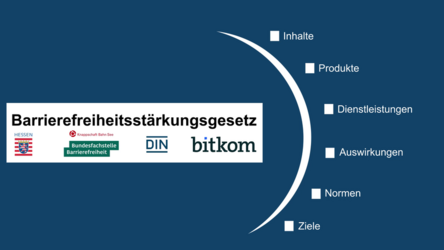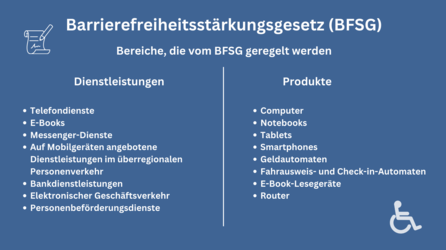
Table of contents
Accessibility Reinforcement Act 2025: Complete guide
The Barrierefreiheitsstärkungsgesetz (BFSG), which comes into force on 28 June 2025, marks a significant step towards promoting digital inclusion in Germany. It aims to remove barriers in the area of digital products and services in order to enable people with disabilities to participate in social life on an equal footing and without discrimination. This law affects not only public institutions, but also companies in the B2C sector in particular, such as online shops and website operators.
Background and objectives of the BFSG
The BFSG serves to implement Directive (EU) 2019/882 of the European Parliament and of the Council on accessibility requirements for products and services, known as the European Accessibility Act (EAA). In contrast to EU regulations, which are directly applicable, this directive had to be implemented by national laws in the member states. In Germany, this is done by the BFSG, which thus transposes the European requirements into national law.
The main aim of the law is to remove barriers in digital media for people with disabilities. It aims to ensure that products and services are accessible and usable for all people, regardless of their abilities. This not only promotes individual autonomy and participation, but also strengthens social cohesion and economic participation.
Who is affected by the BFSG?
The BFSG is aimed at manufacturers and providers of certain products and services in the B2C sector. Companies that manufacture or sell products such as smartphones, tablets, computers, e-book readers and self-service terminals such as cash and ticket machines are affected. Services such as telecommunications services, banking services, e-books, e-commerce and passenger transport services are also covered by the law.
It is important to note that micro-enterprises that provide or offer services and employ fewer than ten people and have an annual turnover or annual balance sheet total of no more than two million euros are exempt from the regulations. However, this exemption does not apply to micro-enterprises that manufacture or sell products such as smartphones or e-book readers. This means that even small online retailers that sell such products must fulfil the accessibility requirements.
Effects on online shops and website operators
For online shops and website operators, the BFSG means that they must make their digital offerings accessible by 28 June 2025. This applies not only to the desktop versions of their websites, but also to mobile applications and apps. Accessibility covers various aspects:
Perceivability of content: All information and components of the user interface must be perceptible for users with different abilities. This means, for example, that images must be provided with alternative texts so that screen readers can interpret them. Videos should contain subtitles or transcripts so that they are also accessible to people with hearing impairments.
Usability of the user interface: The navigation and all interactive elements of the website must be designed in such a way that they can also be operated without a mouse, for example using only the keyboard. This is particularly important for people with motor impairments.
Comprehensibility of the information: The content should be written in clear and simple language. Technical jargon and complicated sentence structures can pose considerable challenges for people with cognitive impairments. An intuitive design also supports general user-friendliness.
Robustness of the content: The website should be developed to be compatible with different technologies and assistive devices. This includes support for screen readers and other assistive technologies.
Concrete requirements and implementation
The precise requirements for accessibility are set out in the BFSG ordinance, which was published in the Federal Law Gazette on 22 June 2022. This ordinance is based on international standards such as the Web Content Accessibility Guidelines (WCAG) 2.1 and provides detailed specifications on how accessibility can be implemented in terms of technology and design.
In order to fulfil the requirements, website operators should take the following steps:
Analyse the current website: Identify existing barriers and determine which areas need to be adapted. This can be done using specialised tools or by accessibility experts.
Plan the adaptations: Develop a detailed plan for implementing the necessary measures. Take into account technical changes, design adjustments and the creation of accessible content.
Technical implementation: Implement the necessary technical adaptations. This can include adapting the HTML code, improving keyboard operability or integrating ARIA attributes that provide screen readers with additional information.
Content customisation: Revise text, images and multimedia content. Ensure that all content is written in plain language and that alternative texts are available for non-textual content.
Accessibility testing: Carry out tests to ensure that your website fulfils the requirements. This can be done through automated testing, manual testing or by involving people with disabilities.
Employee training: Sensitise your team to the topic of accessibility and train them in the creation of accessible content. This will ensure that future content also meets the requirements.
Adaptation of legal texts and information obligations
In addition to the technical and content-related adaptation of the website, legal aspects must also be taken into account. The BFSG stipulates that companies must inform their customers about the accessibility of their offers. These information obligations should be implemented in the general terms and conditions (GTC) or in another suitable place on the website.
The information must also be accessible without barriers. This means that legal texts must be written in simple language and technically provided in such a way that they can be recognised by assistive technologies. Companies should therefore revise their general terms and conditions, data protection declarations and other legal notices accordingly.
Legal consequences of non-compliance
Companies that do not meet the requirements of the BFSG risk significant legal consequences from 28 June 2025. The market surveillance authorities can impose fines of up to 100,000 euros for violations. In addition, consumers and associations can report violations and take legal action if necessary.
Warnings from competitors or consumer protection organisations are also possible if non-compliance with accessibility requirements is deemed to be a breach of competition law. In addition to financial damage, this can also lead to a loss of image and damage customer confidence.
Advantages of accessibility for companies
The implementation of accessibility requirements not only offers legal security, but also numerous other advantages for companies:
Expansion of the target group: Accessible offers are accessible to more people, which can lead to a wider reach and potentially higher sales.
Improved usability: Accessibility measures often increase the overall usability of the website, which increases the satisfaction of all users.
Positive impact on SEO ranking: Search engines often rank accessible websites higher because they are structured and accessible.
Strengthening the corporate image: By implementing accessibility, companies demonstrate social responsibility and promote a positive brand image.

Reach our specialists for accessible web design
We are here to help you. Together we can master your digital challenges and promote inclusion on the Internet. Let us make your projects successful with accessible web design.
Criticism and outlook
Although the BFSG represents an important step towards inclusion, it has also been criticised by disability associations. They criticise the fact that the law only implements minimum standards, contains too many exceptions and the transition periods are too long. In addition, they believe that further-reaching measures are lacking to ensure full participation.
Nevertheless, the law provides a basis on which to build. Companies have the opportunity to go beyond the legal requirements and thus make a contribution to a more inclusive society.
Conclusion and recommendations for action
The Accessibility Reinforcement Act 2025 presents companies with new challenges, but also offers the opportunity to position themselves favourably and tap into new customer groups. Addressing the requirements at an early stage and implementing them consistently are crucial in order to avoid legal risks and utilise the benefits.
Recommendations for companies:
Start planning and implementing the accessibility requirementsearly in order to meet the deadline of 28 June 2025.
Use external expertise, for example by working with accessibility experts or specialised agencies.
Train your employees in the use of accessible technologies and content to ensure sustainable implementation.
Activelycommunicate your accessibilitymeasures to your customers in order to create transparency and strengthen trust.
Regularly check your offers for accessibility to ensure continuous improvements.
Accessibility Reinforcement Act 2025
This picture gallery shows various aspects and measures that are being implemented as part of the Accessibility Improvement Act in order to create a more inclusive society.

Ein moderner Arbeitsplatz in einem sonnendurchfluteten Büro. Auf einem großen Monitor ist die Überschrift "BFSG Guide 2025" zu sehen, umgeben von Symbolen, die Barrierefreiheit und Inklusion darstellen, wie das Rollstuhl-Symbol, Gebärdensprach-Symbole und visuelle Indikatoren. Der Schreibtisch ist mit technischen Geräten und einer Pflanze dekoriert.

Ein Infografik-Bild mit blauer Hintergrundfarbe, das die Anforderungen des Barrierefreiheitsstärkungsgesetzes (BFSGV) erläutert. Darunter fallen bedienbare Identifizierungs- und Sicherheitsfunktionen, die Bereitstellung von Informationen über mehrere sensorische Kanäle, angemessene Schriftgrößen und Kontraste sowie alternative Darstellungen für visuelle Inhalte.

Eine Infografik mit dem Titel "Barrierefreiheitsstärkungsgesetz". Das Bild zeigt die Logos verschiedener Organisationen wie "DIN" und "Bitkom" sowie Stichworte wie "Inhalte", "Produkte", "Dienstleistungen", "Normen" und "Ziele", die den Anwendungsbereich des Gesetzes darstellen.

Eine Übersichtsgrafik mit einer Auflistung der Bereiche, die das BFSG regelt. Auf der linken Seite sind Dienstleistungen wie Telefondienste, E-Books und Bankdienstleistungen aufgelistet, auf der rechten Seite Produkte wie Computer, Smartphones und Geldautomaten. Am unteren Rand befindet sich ein Rollstuhl-Symbol.

Ein von KI erzeugtes Bild zeigt eine robuste Kette in Grün, verziert mit Barrierefreiheitssymbolen, die das Barrierefreiheitsstärkungsgesetz darstellen. Kraftvoll und unterstützend!
Frequently asked questions
What is the Accessibility Improvement Act 2025?
The Barrierefreiheitsstärkungsgesetz (BFSG) is a German law that comes into force on 28 June 2025. It implements EU Directive 2019/882 and aims to remove barriers in digital media for people with disabilities in order to promote their equal participation in social life.
Who is affected by the BFSG?
The law affects manufacturers and providers of certain products and services in the B2C sector, in particular online shops and website operators. Micro-enterprises with fewer than 10 employees and an annual turnover or an annual balance sheet total of no more than €2 million are exempt, provided they do not sell any of the aforementioned products.
Which products and services are covered by the BFSG?
Affected products include smartphones, tablets, computers, e-book readers and cash and ticket machines. Services include telecommunication services, banking services, e-books, e-commerce and passenger transport services.
What does accessibility actually mean for my website or online shop?
Your digital offerings must be designed in such a way that they are accessible and usable for people with disabilities without any particular difficulty. This includes, for example, clear and simple language, sufficient contrast, alternative texts for images, keyboard operability and compatibility with screen readers.
By when must the requirements be implemented?
The accessibility requirements must be fully implemented by 28 June 2025. There is no additional implementation deadline after this date, so companies should start planning early.
What are the consequences of non-compliance with the BFSG?
Fines of up to 100,000 euros can be imposed for infringements. In addition, consumers and associations can take legal action and there is a risk of warnings due to competition law infringements.
Are mobile applications and apps also affected?
Yes, the BFSG applies to websites as well as mobile applications and apps. These must also be designed to be accessible.
How can I check whether my company qualifies as a microenterprise?
Your company is considered a micro-enterprise if it employs fewer than 10 people and has an annual turnover or an annual balance sheet total of no more than 2 million euros.
What are the benefits of implementing accessibility for my company?
Accessible offers allow you to reach a larger target group, improve user-friendliness for all users, strengthen your corporate image and benefit from possible SEO advantages.
Where can I find support and further information on implementing the BFSG?
You can refer to the guidelines of the Federal Ministry of Labour and Social Affairs, study the legal ordinance on the BFSG or consult experts on accessibility.
